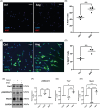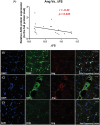Protective role of Angiogenin in muscle regeneration in amyotrophic lateral sclerosis: Diagnostic and therapeutic implications
- PMID: 39731449
- PMCID: PMC12145901
- DOI: 10.1111/bpa.13328
Protective role of Angiogenin in muscle regeneration in amyotrophic lateral sclerosis: Diagnostic and therapeutic implications
Abstract
Amyotrophic lateral sclerosis (ALS) is a fatal neuromuscular disease with no effective treatments, in part caused by variations in progression and the absence of biomarkers. Mice carrying the SOD1G93A transgene with different genetic backgrounds show variable disease rates, reflecting the diversity of patients. While extensive research has been done on the involvement of the central nervous system, the role of skeletal muscle remains underexplored. We examined the impact of angiogenin, including its RNase activity, in skeletal muscles of ALS mouse models and in biopsies from ALS patients. Elevated levels of angiogenin were found in slowly progressing mice but not in rapidly progressing mice, correlating with increased muscle regeneration and vascularisation. In patients, higher levels of angiogenin in skeletal muscles correlated with milder disease. Mechanistically, angiogenin promotes muscle regeneration and vascularisation through satellite cell-endothelial interactions during myogenesis and angiogenesis. Furthermore, specific angiogenin-derived tiRNAs were upregulated in slowly progressing mice, suggesting their role in mediating the effects of angiogenin. These findings highlight angiogenin and its tiRNAs as potential prognostic markers and therapeutic targets for ALS, offering avenues for patient stratification and interventions to mitigate disease progression by promoting muscle regeneration.
Keywords: Angiogenin; amyotrophic lateral sclerosis; biomarkers; skeletal muscle; tiRNAs.
© 2024 The Author(s). Brain Pathology published by John Wiley & Sons Ltd on behalf of International Society of Neuropathology.
Conflict of interest statement
The authors declare no conflicts of interest.
Figures








Similar articles
-
P2X7 activation enhances skeletal muscle metabolism and regeneration in SOD1G93A mouse model of amyotrophic lateral sclerosis.Brain Pathol. 2020 Mar;30(2):272-282. doi: 10.1111/bpa.12774. Epub 2019 Aug 18. Brain Pathol. 2020. PMID: 31376190 Free PMC article.
-
Differentially expressed lncRNAs in SOD1G93A mice skeletal muscle: H19, Myhas and Neat1 as potential biomarkers in amyotrophic lateral sclerosis.Open Biol. 2024 Oct;14(10):240015. doi: 10.1098/rsob.240015. Epub 2024 Oct 16. Open Biol. 2024. PMID: 39406341 Free PMC article.
-
Angiogenin induces modifications in the astrocyte secretome: relevance to amyotrophic lateral sclerosis.J Proteomics. 2013 Oct 8;91:274-85. doi: 10.1016/j.jprot.2013.07.028. Epub 2013 Aug 3. J Proteomics. 2013. PMID: 23920243
-
Therapeutics Targeting Skeletal Muscle in Amyotrophic Lateral Sclerosis.Biomolecules. 2024 Jul 22;14(7):878. doi: 10.3390/biom14070878. Biomolecules. 2024. PMID: 39062592 Free PMC article. Review.
-
Effects of Pathogenic Mutants of the Neuroprotective RNase 5-Angiogenin in Amyotrophic Lateral Sclerosis (ALS).Genes (Basel). 2024 Jun 4;15(6):738. doi: 10.3390/genes15060738. Genes (Basel). 2024. PMID: 38927674 Free PMC article. Review.
References
MeSH terms
Substances
Grants and funding
LinkOut - more resources
Full Text Sources
Medical
Miscellaneous

